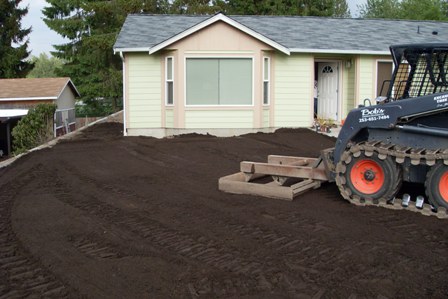Topsoiling

Definition
Preserving and using topsoil to provide a suitable growth medium and enhance final site stabilization with vegetation.
Where Practice Applies
- Where a sufficient supply of quality topsoil is available.
- Where slopes are 2:1 or flatter.
-
Where the subsoil or areas of existing surface soil present the following problems
- The structure, pH, or nutrient balance of the available soil cannot be amended by reasonable means to provide an adequate growth medium for the desired vegetation.
- The soil is too shallow to provide adequate rooting depth or will not supply necessary moisture and nutrients for growth of desired vegetation.
- The soil contains substances toxic to the desired vegetation.
- Topsoiling is strongly recommended where ornamental plants or high maintenance turf will be grown.
Advantages
- Advantages of topsoil include higher organic matter and greater available water- holding capacity and nutrient content.
- Topsoil stockpiling ensures that a good growth medium will be available for establishing plant cover on graded areas.
- The stockpiles can be used as noise and view baffles during construction.
Disadvantages/Problems
- Stripping, stockpiling, and re-applying topsoil, or importing topsoil may not always be cost-effective. It may also create an erosion problem if improperly secured.
- Unless carefully located, storage banks of topsoil may also obstruct site operations and therefore require double handling.
- Topsoiling can delay seeding or sodding operations, increasing exposure time of denuded areas.
- Most topsoil contains some weed seeds.
Planning Considerations
- Topsoiling may be required to establish vegetation on shallow soils, soils containing potentially toxic materials, very stony areas, and soils of critically low pH.
- Topsoil is the surface layer of the soil profile, generally characterized as being darker than the subsoil due to the presence of organic matter. It is the major zone of root development and biological activities for plants, carrying much of the nutrients available to plants, and supplying a large share of the water used by plants. It should be stockpiled and used wherever practical for establishing permanent vegetation.
- The need for topsoiling, should be evaluated. Take into account the amount and quantity of available topsoil and weigh this against the difficulty of preparing a good seedbed on the existing subsoil. Where a limited amount of topsoil is available, it should be reserved for use on the most critical areas.
- Make a field exploration of the site to determine if there is surface soil of sufficient quantity and quality to justify stripping. Topsoil should be spread at a depth of 2 to 4 inches. More topsoil will be needed if the subsoil is rocky.
- Topsoil should be friable and loamy (loam, sandy loam, silt loam, sandy clay loam, clay loam). Areas of natural ground water recharge should be avoided.
- Allow sufficient time in scheduling for topsoil to be spread and bonded prior to seeding, sodding, or planting.
- Do not apply topsoil if the subsoil has a contrasting texture. Sandy topsoil over clayey subsoil is a particularly poor combination; water can creep along the junction between the soil layers and causes the topsoil to slough.
Stripping
Stripping should be confined to the immediate construction area. A 4 to 6 inch stripping depth is common, but depth may vary depending on the particular soil. All surface runoff control structures should be in place prior to stripping.
Stockpiling
- Locate the topsoil stockpile so that it does not interfere with work on the site. Side slopes of the stockpile should not exceed 2:1.
- Surround all topsoil stockpiles with an interceptor dike with gravel outlet and silt fence.
- Either seed or cover stockpiles with clear plastic or other mulching materials within 7 days of the formation of the stockpile.
Placement
Topsoil should not be placed while in a frozen or muddy condition, when the subgrade is excessively wet, or when conditions exist that may otherwise be detrimental to proper grading or proposed sodding or seeding.
Do not place topsoil on slopes steeper than 2:1, as it will tend to slip off.
If topsoil and subsoil are not properly bonded, water will not infiltrate the soil profile evenly and it will be difficult to establish vegetation. The best method is to actually work the topsoil into the layer below for a depth of at least 6 inches.
Maintenance
Maintain protective cover on stockpiles until needed.
References
Massachusetts Department of Environmental Protection, Office of Watershed Management, Nonpoint Source Program, Massachusetts Nonpoint Source Management Manual, Boston, Massachusetts, June, 1993.
Washington State Department of Ecology, Stormwater Management Manual for the Puget Sound Basin, Olympia, WA, February, 1992.